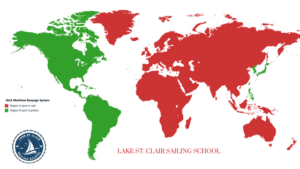When we look to trimming our mainsail, we really do need to understand the principles of sail twist and why sail twist is so important.
As your boat sails along, the wind hitting the top of the sail is a little bit stronger than the wind hitting the bottom of the sail. For this reason, the top of the sail needs to be slightly looser than the bottom. This is where sail twist comes in. By using the mainsheet, the traveller, and the vang, depending on the point of sail, we can get air to move smoothly and drive the boat across all points of that mainsail. This will lead you to have an increase in speed.
Main Sail Twist
The main ways to assess twist are twofold. Number one, look at the sail. You can see the difference in position between the two and the bottom of the sail. The other one? Yep, back to those telltales. Look to see if all the telltales are flying.
Upwind, we need to use the mainsheet and the traveler to control the twist. Aside from changing the position of the mainsail, the sheet also exerts a huge amount of force on that sail. By hauling the mainsheet in, you pull the sail down. This exerts a downward force on the sail and it removes twist. It does this by closing the leech, or flattening the sail a little bit, and what you will find is that the telltale will fall to leeward.
So adjust the mainsheet until the upper telltale flies fully from the leech of the sail. Then your twist is set. As a rule of thumb, this will occur when the upper camber stripe is parallel to the boom.
Once you’ve set the twist, you can then use the traveller to adjust the position of the mainsail to depower the sail if it becomes too windy or you have gusts. And at all times maintain the twist in the sail. Our traveller is located on the coach roof, but a lot of them are elsewhere – cockpits and at the stern.
The traveler is normally kept in a central location; however, in lighter airs, you can move it to windward, and in windier conditions you can move it to leeward. All this is going to increase your boat speed.
What about light wind?
In light airs, this means that you can ease the sheet and keep the boom in the centerline position. Easing the sheet allows the boom to rise a little bit, thus maintaining the twist and driving the boat forward – greater speed.
Trimming Sails downwind
Sailing downwind is slightly different. Once the boom has passed to leeward of the traveler, you need to use the kicker or the vang to control the leech tension and therefore the twist.
Off the wind, by easing the kicker, you allow the boom to rise. This opens the leech and the twist increases. Contrarily, tightening the kicker will close the leech and decrease the twist. And you often need to adjust this because otherwise you’ll get too much twist in the sail as you’re sailing downwind. Again, make sure you look at those telltales.
For those of you who are now like, “Wait, what the hell just happened? What was that all about?”, it is really straight forward. You’re on a sailboat, you pick the point of sail that you want to get to, and you adjust your mainsheet first to get the twist set. Then, once you’ve set your twist, you use the traveler to control the sail angle.
Sailing downwind is slightly different because as you let the boom and the sail out, you have no effect on the traveler. This means that you have to control the twist of the sail using the vang or kicker.
What a lot of people do when they’re starting to learn to sail is they use the mainsheet to control the sail angle for all points of sail and at all wind strengths. And while that is a really basic way of adjusting the angle of the sail to the boat and thus also the wind, it also means that you are changing the twist in your sail and losing performance.
Keep an eye up on the Hawk
Now, this brings me on to the next bit that I really do want to talk to you about, which is how you assess the boat going faster. A lot of the time you just use the instruments. You use your log and you use the wind strength gauge, the anemometer, to work out what the wind strength and direction is.
But there’s a hawk at the top of your mast which will show you the wind direction, and really, without going into all this Miyagi stuff, you should be able to feel the boat. You’ll be able to feel the boat. Each boat is different, and each boat has a groove – a groove where it’s really happy. In modern monohull construction, there are chines on boats so the boat will sit in a groove at a certain heeling angle. We know Ruby Rose, and I know exactly when she’s happiest.
Feel the sailboat
So feel the boat, look for little increases in speed, and look up at the sail. Continually look up at your sail, look at your twist. If you’re sat in a good helm position, you should be able to look at your mainsail and go,
Take too much twist away, flatten the sail by pulling down too hard, you’ll lose the twist. If that is wrong for the wind direction and wind speed, the telltale will fall. Similarly, put too much twist in and you will again see the telltale fall and you’re losing performance. So it’s about making sure that you understand that twist occurs because the wind is stronger at the top of the sail or the top of the mast than it is at the bottom, and adjusting your sail accordingly. It is as simple as that.
Number one, get your twist right. Number two, then play with the traveler and the vang to adjust the angle of the mainsail to the boat. Simple as.
The second way I can make the sailboat goes faster
The second way that I can make you sail faster is by asking you to look at and adjust your leech lines. If your mainsail doesn’t have leech lines, get some fitted. If you are ordering a mainsail when it comes to change your sails, ask your sailmaker to include low-stretch leech lines. For us, we always ask for Spectra because it is very, very, very hard-wearing and very low-stretch.
Now, what are leech lines?
They are small – in our case, I think they’re 4 millimeter – lines that run on the leech or the aft edge of the sail. They run through the sail, and there is a small cleat. There are cleats placed at every reef point, actually, that allow you to tension the leech of our mainsail.
Why would we need to do this? Because if you look up at a mainsail with an incorrectly tensioned leech, you will see that the upper edge is fluttering a little bit. That flutter means that you’re not getting the drive from your sail that you need to. So what you do is go out on a moderately breezy day – not anything crazy – and look at the upper edge of your sail. If you see that it’s fluttering a little bit, adjust your leech line. Tension it slightly until that flutter stops. Also, be careful not to over tension it. If you pull down too hard, you’ll induce a curl into the back of your sail, and that actually stops it driving. So a small adjustment, and do it fairly regularly.
In addition to this, keeping your mainsail, especially laminate sails, from fluttering too much extends their life. Using Point 2, adjustment of leech lines or inclusion of leech lines, you will find that one, you will go faster, and two, your mainsail will last longer.
The Third way I can make the sailboat goes faster
The third way you can get your boat to move faster is to understand outhaul and luff tension. Those are two separate things. The outhaul pulls the foot of the sail back and adds drive to the boat depending on the wind condition. The luff tension is adjusted by, in many cases, on big boats, adjusting the tension of the main halyard – but also, it can be pulled down using something called a Cunningham. We don’t have one of those; we only use our main halyard tension.
This is the reason I was talking before about camber stripes. A mainsail has a maximum draft that the sailmaker will build into it to allow the sail to drive most efficiently. As the wind strength increases, the camber will move back. By increasing luff tension, you can pull that camber forward again. Think like an airplane wing. It’s the front part of the wing that has the greatest thickness, and then it moves to the back to be more streamlined.
Therefore, you should adjust your mainsail halyard tension to allow this. Once you’ve adjusted this, put little marks on your halyard to understand where the luff tension is best for different upwind or downwind conditions. By adjusting your halyard tension, looking at the camber, and looking at your camber stripes, you will see where the maximum camber is, the maximum depth, and adjust accordingly.
Now I want to talk to you about the outhaul of your sail. In the lower end of the sail’s range, in lighter winds, you will find that a looser outhaul allows the sail to drive better. However, as the sail reaches its working range, flattening the outhaul will give you a better aerodynamic shape and your boat will move faster.
The other thing is by flattening the outhaul in heavier winds, you reduce weather helm. These two things will allow you to steer faster, steer better, and the boat will go faster. So the third tip for us: Work on your outhaul tension and look at your camber tension. Those three things will make you sail faster. So, did you go any faster? Did those three methods help you sail faster? Let us know. Put a comment down below. Also, we are doing a fantastic offer with Precision Sails, so if by any chance you are interested in Precision Sails or a new set of sails,
Parts of the a sailboat
- Backstay
A backstay runs from the mast to the rear quarter, counteracting the forestay and jib. - Boom
In sailing, a boom is a spar (pole), along the foot of a fore and aft rigged sail,[1] that greatly improves control of the angle and shape of the sail. The primary action of the boom is to keep the foot flatter when the sail angle is away from the centerline of the boat. - Boom Vang
A boom vang (US) or kicking strap (UK) is a line or piston system on a sailboat used to exert downward force on the boom and thus control the shape of the sail. The Collins English Dictionary defines it as “A rope or tackle extended from the boom of a fore-and-aft mainsail to a deck […] - Forestay
On a sailing vessel, a forestay, sometimes just called a stay, is a piece of standing rigging which keeps a mast from falling backwards. It is attached either at the very top of the mast, or in fractional rigs between about 1/8 and 1/4 from the top of the mast. - Hull
The hull is the watertight body of a ship or boat. Above the hull is the superstructure and/or deckhouse, where present. The line where the hull meets the water surface is called the waterline. Reference: Wikipedia - Jib
A jib is a triangular sail that sets ahead of the foremast of a sailing vessel. Its tack is fixed to the bowsprit, to the bows, or to the deck between the bowsprit and the foremost mast. Jibs and spinnakers are the two main types of headsails on a modern boat. Reference: Wikipedia - Keel
On boats and ships, keel can refer to either of two parts: a structural element that sometimes resembles a fin and protrudes below a boat along the central line, or a hydrodynamic element. These parts overlap. As the laying down of the keel is the initial step in the construction of a ship, in British […]
- Mainsail
A mainsail is a sail located behind the main mast of a sailing vessel. - Mast
The mast of a sailing vessel is a tall spar, or arrangement of spars, erected more or less vertically on the centre-line of a ship or boat. Its purposes include carrying sail, spars, and derricks, and giving necessary height to a navigation light, look-out position, signal yard, control position, radio aerial or signal lamp. Large […] - Rudder
A rudder is a primary control surface used to steer a ship, boat, submarine, hovercraft, aircraft, or other conveyance that moves through a fluid medium (generally air or water). On an aircraft the rudder is used primarily to counter adverse yaw and p-factor and is not the primary control used to turn the airplane. A […]
- Sheet
In sailing, a sheet is a line (rope, cable or chain) used to control the movable corner(s) (clews) of a sail. Reference: Wikipedia - Shroud
On a sailboat, the shrouds are pieces of standing rigging which hold the mast up from side to side. There is frequently more than one shroud on each side of the boat. Usually a shroud will connect at the top of the mast, and additional shrouds might connect partway down the mast, depending on the […] - Spinnaker
A spinnaker is a sail designed specifically for sailing off the wind from a reaching course to a downwind, i.e. with the wind 90°–180° off bow. The spinnaker fills with wind and balloons out in front of the boat when it is deployed, called flying. It is constructed of lightweight fabric, - Spinnaker Pole
A spinnaker pole is a spar used in sailboats (both dinghies and yachts) to help support and control a variety of headsails, particularly the spinnaker. However, it is also used with other sails, such as genoas and jibs, when sailing downwind with no spinnaker hoisted. - Spreader
A spreader is a spar on a sailboat used to deflect the shrouds to allow them to better support the mast. Often, there are multiples, called spreaders. The spreader or spreaders serve much the same purpose as the crosstrees and tops in a traditional sailing vessel. Spreader design and tuning can be quite complex. - Staysail
A staysail is a fore-and-aft rigged sail whose luff can be affixed to a stay running forward (and most often but not always downwards) from a mast to the deck, the bowsprit, or to another mast. - Tiller
A lever used for steering, attached to the top of the rudder post. Used mainly on smaller vessels, such as dinghies and rowing boats.




